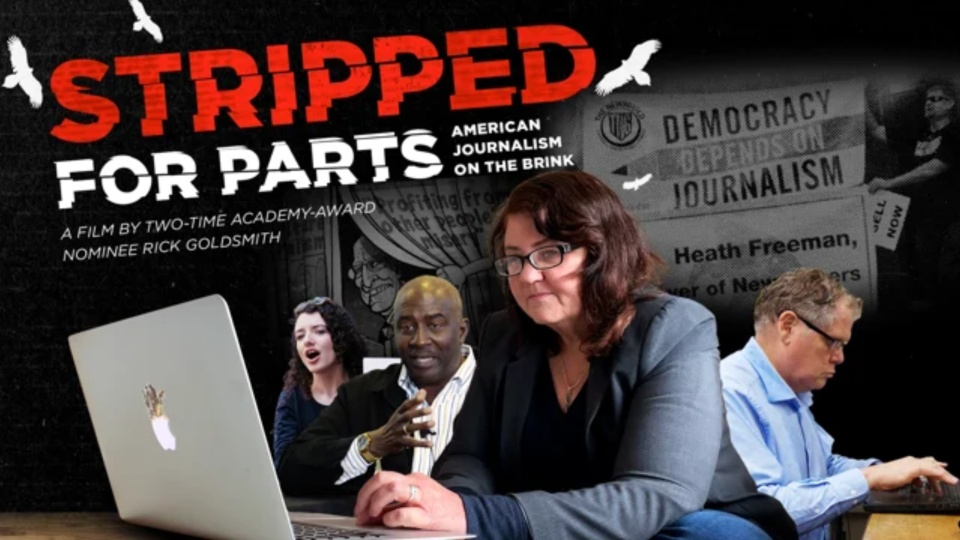
Two-time Academy Award-nominated film director Rick Goldsmith has completed his trilogy on the American press with his latest film, the explosive exposé Stripped for Parts: American Journalism on the Brink. The documentarian focuses on Alden Global Capital, a secretive investment group, called a “hedge fund,” with investments in American newspapers with the ultimate intent to destroy them, fire or retire journalists, subject them to editorial control, and decimate their resources by selling off their often historic buildings in downtown cities that, as real estate, are worth far more than the value of the enterprise itself. Such investment groups are subject to only the very weakest oversight, if any, from the Securities and Exchange Commission.
The two previous entries in the Goldsmith trilogy are The Most Dangerous Man in America: Daniel Ellsberg and the Pentagon Papers (2009), and Tell the Truth and Run: George Seldes and the American Press (1996). The new film is extremely timely as media and newspapers are now about to go on strike. News of the strike, affecting 11 newsrooms in Southern California, can be read here in Media Post. Many of the 125 reporters, photographers, digital, social media, and production staff represented by the Southern California News Group Guild have not had a raise in ten years, and despite their high degree of professionalism, are still earning under $20 an hour.
Briefly, Stripped for Parts is the story not just of one destructive, anti-democratic hedge fund that is plundering America’s newspapers, but just as important, of the journalists who are fighting back. Investigative reporter Julie Reynolds, Denver Post editorialist Chuck Plunkett, and a handful of others, backed by the NewsGuild union, go toe-to-toe with the faceless Alden Global Capital in a battle to save and rebuild local journalism across America. Who will control the future of America’s news ecosystem: Wall Street billionaires concerned only with profit, or those who see journalism as an essential public service and the lifeblood of our democracy?
Denver plays a central role in the story as Goldsmith tells it. At the time of the Aurora shooting, the Denver Post had a staff of 150 and won a Pulitzer Prize for its coverage. Yet in the middle of all that great reporting, the new vulture capitalist owners announced a major staff cut.
In city after city, county after county across America, where newspapers fail, or continue to print what are basically computer-generated stories with no informed local input, city council meetings are no longer covered, taxes go up because there’s no watchdog to report on them, and public services decline. Where no one is paying attention, citizens will never know about redevelopment plans, school board decisions, corruption in high places, conditions in prisons, and everything they need to know to properly cast votes and advocate for issues they care about. No wonder Donald Trump says he loves the uneducated!
Not that the old model of the newspaper business was perfect either. Critics often point to the great heyday of America’s newspapers as conduits for advertising to the public. Almost from the beginning, revenue from ads far surpassed that from subscribers or newsstand buyers. And advertisers, of course, could and often did make demands on editorial content. Aiming at readers who were wealthier, more educated, and “respectable,” publishers often neglected to cover labor and consumer issues, housing, alternative politics, education, pollution, and issues concerning youth and women, among other critical topics.
Hedge funds, like Alden, like to attribute the decline of newspapers to the internet, where readers and advertisers both have migrated and claim that by contrast, they are “saving” newspapers. But in many ways, this is a self-serving interpretation. Of course, if your local rag that was once a feisty investigative daily and is now little more than a weekly shopper with corporate-written articles contributing no information of value to your grasp of local issues, then why would you even bother to pick it up even for free, much less subscribe?
Watching this film, my mind turned to the movie, and the play it was based on, Other People’s Money, which was about this very topic, but in the case of failing industries. It was the same business strategy employed by Bain Capital, where Mitt Romney also amassed a fortune at the expense of ordinary working people who often lost not only their livelihood but in many instances their retirement pensions as well. Perhaps this is what presidential candidate Kamala Harris is talking about when she promises to shore up small businesses that are so vital to the American economy, and not just the über-rich favored by the Trump crowd.
The implications of the hedge fund business model extend far beyond the media, as Goldsmith elaborated in a post-screening interview at Los Angeles’ Laemmle Royal on Saturday night. How about the somewhat peculiar new interest hedge funds are showing in buying up trailer parks? What’s in it for them? Increased rents, for sure. But maybe, ultimately, as tenants die or move away, it’s also just about the real estate. And big corporations are—how crazy is this?—buying up single-family homes in communities all across America. What do they want with them? Well, also to rent them, not turn them over to new, perhaps first-time buyers, control the housing market, and block by block, neighborhood by neighborhood, start acquiring wholesale ownership of large tracts of land. There is no end in sight to how this business philosophy can be applied. People who do nothing, make nothing, serve nothing, just manipulate capital to make more capital. This is a superhighway to recession, depression, and to authoritarian politics as the way out. The Stop Wall Street Looting Act, supported by Senators Schumer and Warren, has gone nowhere.
The journalists’ decision to fight back was not an easy one. Writers are hard-wired to search out crime and unfairness and expose it, for which all Americans can be grateful. For the most part, they believed their publishers supported them—it’s why they were paid to work in their chosen profession. But they never thought they would be in a position where they’d have to turn the tables on their own parasitic employers if they would retain their jobs and their dignity. As investigative reporters they started looking into the operations of these hedge funds, uncovering networks of shady corporations with nameless investors based on the Isle of Jersey or in the Cayman Islands.
As the owners take control of their “distressed asset investments,” one tactic they often employ is to offer buyouts of top reporters and editors, partly to reduce the staff and also to deprive the paper of its institutional memory and traditions, making the remaining workforce more timid and subservient. And as these workers became less fulfilled in their jobs, they, too, would voluntarily leave the profession.
The newspaper staff (some unionized, others not) have raised the demand that if the anonymous hedge fund owners truly didn’t want to run a successful newspaper, but only run it into the ground for the leavings, then they should sell it. But who would buy it? Segments of Goldsmith’s film have to do with this search, and generally, it’s a very wealthy person who either has a vision of how to make a new go at the business with a fresh approach or is civic-minded enough to contemplate taking a loss, at least at first, until the paper recovers and starts to become profitable again.
Or not. Perhaps it’s wiser to acknowledge the folly of thinking a billionaire could save journalism. Could a nonprofit model work? Maybe a municipality or a county might subsidize, or even own its own newspaper. Perhaps, as is still the rare case, a labor federation might sponsor a newspaper. Maybe the paper could be worker-owned. Goldsmith shows how in several cities new media, mostly digital, have emerged out of the ashes of the decimated newspapers.
Other substantial elements in the documentary are short embedded history lessons showing that the American government, from the outset, recognized the importance of an informed public. As early as the 1792 Postal Act, the government offered a reduced postal rate on newspapers precisely so that it would favor the dissemination of news and views as a service, not a commodity. In fact, just read the Constitution. The First Amendment in the Bill of Rights states:
“Congress shall make no law respecting an establishment of religion, or prohibiting the free exercise thereof; or abridging the freedom of speech, or of the press; or the right of the people peaceably to assemble, and to petition the Government for a redress of grievances.”
There it is: the only business or industry intentionally mentioned by name in our founding document—the press. That is the value of journalism enshrined by those who relied on freedom to say what they wanted in the face of British suppression of speech. No longer could a person be put on trial, fined, or imprisoned for insulting the King. Quite a far cry from setting out to destroy the spread of information! Still, as of recent surveys, despite the existence of public radio and the Corporation for Public Broadcasting, the U.S. sits at the bottom of developed countries in public support of independent media.
Keep your eye out for Stripped for Parts. It may be about 10 or 15 minutes too long, but that’s a minor criticism. It will fascinate and inspire, educate, and move you. Watch the trailer here. A 30-minute labor-produced forum on the film can be viewed here.
We hope you appreciated this article. At People’s World, we believe news and information should be free and accessible to all, but we need your help. Our journalism is free of corporate influence and paywalls because we are totally reader-supported. Only you, our readers and supporters, make this possible. If you enjoy reading People’s World and the stories we bring you, please support our work by donating or becoming a monthly sustainer today. Thank you!










